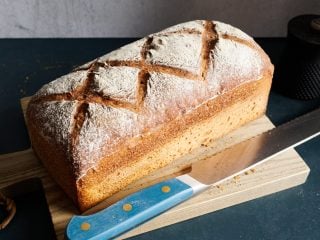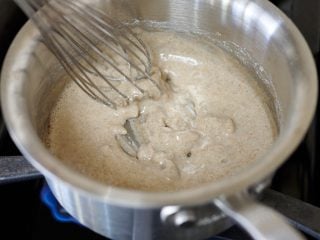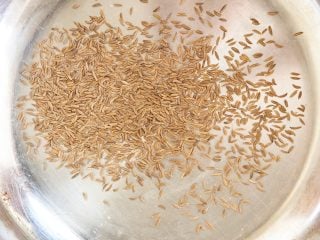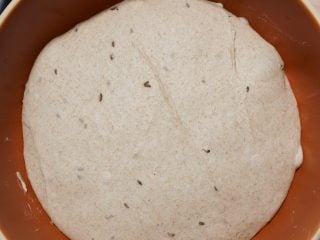Description
This loaf has a great balance of wheat and rye flours. It has a bit of rye flour and scalded rye to add flavor and tenderness, but not so much that the dough is difficult to handle or the flavor of the rye is overwhelming. It makes a perfect sliced bread for ham, roast beef, or leftover Thanksgiving turkey sandwiches.
Ingredients
Scalded Rye Flour Porridge
- 20g Whole Grain Rye Flour
- 60g Water
Main Dough
- 639g Type 85 Bread Flour or high-protein white bread flour
- 160g Whole grain rye flour
- 6g Lightly toasted caraway seeds (optional)
- 615g warm water
- 20g Fine sea salt
- 120g Ripe sourdough starter, (100% Hydration)
- All of the rye porridge
Instructions
- In a small saucepan over medium-low heat, combine the whole-grain rye flour and water. Cook for 3-5 minutes, stirring often, until the mixture has thickened and is glossy. Remove from the heat and let cool.
- Toast the caraway seeds by pre-heating a skillet and shaking the seeds in the hot skillet for about 30 seconds, or just until fragrant.
- In a medium mixing bowl (or in the bowl of a stand mixer fitted with the dough hook attachment), combine the water, sourdough starter, cooled scalded rye, caraway seeds, salt, and flour. Mix until everything is combined. Cover with a clean dish towel and let rest in a warm, draft-free spot for 20 minutes.
- Knead the dough in the bowl. To do so, lift up one side, fold it over the middle and press down. Rotate the bowl a quarter-turn and repeat. Continue lifting and folding for about 5 minutes.
- Let the dough rest, covered with an airtight cover, for three hours in a warm spot—the dough temperature should remain about 78°F (26°C). During this time, give the dough two sets of stretches and folds, one set after 1 hour and a second set after 2 hours.
- After three hours, the dough should have risen noticeably and have bubbles on top and throughout.
- Scoop the dough from the bowl onto a clean work surface. Divide in half and round gently into balls. Let rest on the worksurface for 15 minutes.
- Prepare two 1 lb bread loaf pans (8.5 x 4.5 inches) by liberally coating them with a few tablespoons of neutral oil. Alternatively, a 9 x 4-inch Pullman pan can also be used.
- Shape the loaves. To do so, flour the tops of the rested rounds. Use your bench knife,flip one over so the floured side is down. Pat and stretch the dough into a long oval shape, with the shorter sides closest to and farthest from you. Starting from the top of the loaf, use your fingertips to roll the dough down towards you until it is all rolled into a log shape. Pinch the bottom seam shut. Place the dough, seam-side down, into the prepared pan. Repeat with the other round.
- Loosely cover with a clean dish towel and let the dough proof for about 3 hours. (Alternatively, you can place the loaves in the refrigerator and bake them the next day.) During this time, preheat an empty oven with a rack in the middle to 460°F (238°C).
- After about 3 hours, the dough should have risen noticeably, just touch the rim of the 1 lb. pan, and spring back slowly when pressed. If the dough hasn’t risen or still feels dense, give it more time to proof. To prepare for baking, lightly flour the top of the loaves and score decoratively.
- Bake the loaves for 40 minutes at 460°F (238°C) until the loaves are golden-brown all over.
- Remove the pans from the oven and let cool briefly. Remove the loaves from the pans and let cool on a cooling rack until cool to the touch. These can be eaten once fully cooled, but they are best the next day.
Notes
To make only a single loaf, halve all of the ingredients.
The caraway seeds can be left out or substituted for fennel seeds.
This bread can be made in a traditional 1 lb. pan or a 9 x 4-inch Pullman pan. For additional pans and shaping techniques, see the guide to pan loaves.



